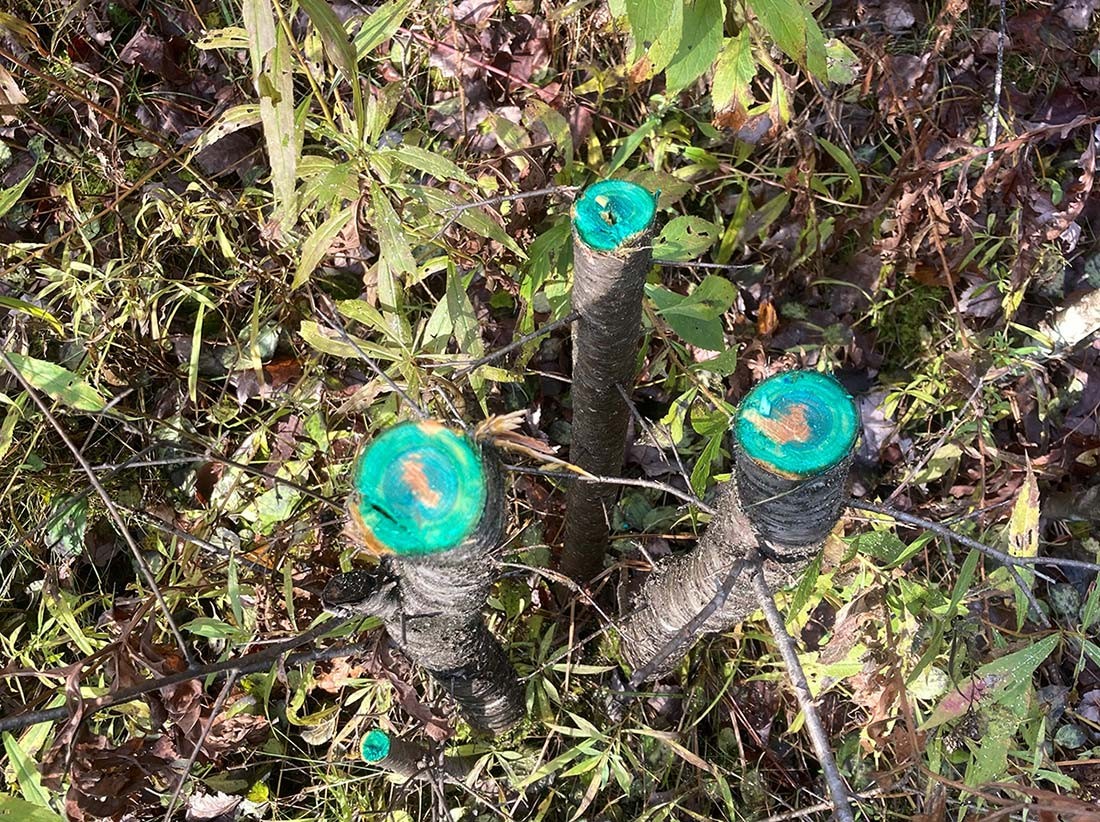
As our forests awaken from a long winter, some plants green-up sooner than others. While many of our native trees and plants remain dormant, the young leaves of woody non-native invasive plants unfurl, creating a green haze in the forest understory. This makes early spring an ideal time to find these invasive plants and to develop a plan to control them in the months ahead.
In general, a non-native species is categorized as invasive when it has the potential to harm native ecosystems. Woody nonnative plants such as buckthorn and non-native honeysuckles, for example, pose a serious threat to biodiversity and to the health, resilience, and productivity of our forests and other ecosystems. These invasives spread prolifically, outcompete native plants, provide less nutritious food for wildlife, support fewer invertebrates, and even disrupt the underground mycorrhizal networks that trees and plants rely on to extract nutrients from the soil and to connect to one another.
The first step in controlling these infestations is identification; that green haze in the early spring woods can make it easy to find these plants and to visualize the density of an infestation. Resources to help identify invasive plants abound, including smartphone apps such as iNaturalist’s Seek.
Once you know which invasive plants are in your forest and the extent of the infestation, you can make a plan to control them. Controlling most infestations of woody invasive plants is completely possible, but it’s important to be realistic about the time this will involve – and to use the right tools for the job.
If you’re dealing with a few plants, mechanical removal – cutting or pulling them – can be effective. Springtime, when the soils are wet, is a great time for hand-pulling. However, most woody invasive plants sprout prolifically from stumps after being cut and from root fragments left in the soil, so you’ll need to repeatedly revisit each area in which you’re working. In the case of cutting, you may need to revisit each individual plant several times a year for several years. If you don’t have the time or energy to sustain that level of commitment over time, this method won’t likely work. While mechanical removal is always a good first choice, it is rarely effective at scale: people either give up or control a small area while the invasives in the rest of their forest thrive.
For this reason, most conservation and land stewardship organizations use some amount of chemical control to deal with invasive plants. You might cringe at the thought of using herbicide, and for good reason: herbicides applied carelessly can have negative consequences on forests. But herbicide can also be an effective restoration tool, an asset that helps rehabilitate unhealthy and degraded forests. It can be applied minimally and conscientiously – directly to the cut surface of stumps or as a low-volume spray applied to the leaves of individual plants.
While I will never feel completely comfortable with it, the use of herbicide has massively increased my ability to control woody invasive plants. It has made the seemingly impossible attainable, allowing me to make progress rather than being stuck in the cycle of controlling the same areas again and again. My favorite tool for herbicide application is the Buckthorn Blaster, a modified bingo dauber that allows me to apply herbicide directly to the surface of a cut stump. While late summer and fall are the best times for cut-stump treatment, it is effective anytime except from March through May, and so I carry my Blaster and a folding handsaw with me almost whenever I walk in the woods.
If you choose to apply herbicide on your own, make sure you’re complying with all relevant laws, pay careful attention to and follow the herbicide’s label, and research what equipment to use and when to apply it to your target species. There are cost-share programs that can help fund this work, such as the Natural Resources Conservation Service’s Environmental Quality Incentives Program (EQIP).
It’s tempting to relish the act of killing invasives, but the ultimate goal should be building and protecting diverse, resilient forests. While we will never eradicate invasive plants, we can control them, keeping populations at a level where we can hand-pull them as they establish and where they constitute a minimal threat to biodiversity. We can develop an active relationship with invasives by learning to identify them, constantly monitoring for them, and using the right tools to remove them.

